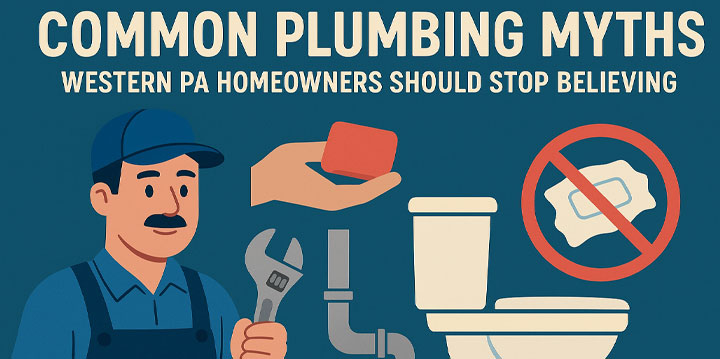
Plumbing systems keep our homes running smoothly, yet myths and misinformation can lead to costly repairs. In Western Pennsylvania, where freezing winters, wet springs, and humid summers put extra stress on pipes and drains, knowing fact from fiction is key. No matter if you’re connected to a municipal sewer or rely on a septic system.
Myth 1: If the drain is working, it must be fine
A slow drain today can turn into a full clog tomorrow. Grease, soap scum, and food particles can collect deep in the line. On septic systems, buildup can push solids where they don’t belong, leading to backups. Regular inspections and professional drain cleaning can help prevent expensive emergencies.
Myth 2: A leaky faucet is no big deal
That steady drip wastes gallons of water each month and can cause rust, rot, or mold. In our region where pipes already deal with seasonal expansion and contraction, small leaks should be fixed quickly before they worsen.
Myth 3: Hot water melts grease so it won’t clog
Hot water only pushes liquefied grease further down the line, where it cools and hardens. Over time, this creates major clogs in both sewer and septic systems. Always collect grease in a container and throw it away in the trash instead.
Myth 4: “Flushable” wipes are safe for toilets
Despite the label, wipes don’t break down like toilet paper. They can snag on roots in older clay pipes common in Western PA, or overwhelm septic tanks. Only flush toilet paper. Everything else belongs in the trash.
Myth 5: Low water pressure is just an annoyance
A sudden drop in pressure could signal leaks underground or behind walls. Ignoring it risks water damage to foundations or septic drain fields. Have it checked before the problem spreads.
Myth 6: High-efficiency toilets don’t work
Early low-flow toilets earned a bad reputation, but today’s high-efficiency models use less than 1.3 gallons per flush while working better than older designs. Look for EPA WaterSense labeled options. Local utilities might even offer rebates.
Myth 7: Chemical drain cleaners are safe for pipes
These products can corrode plumbing, shorten the life of septic systems, and push dangerous chemicals back toward you if misused. Plungers or augers are safer, and when that fails, Armstrong Comfort Solutions can clear the line without damage.
Myth 8: A water heater rumbling means it might explode
That noise usually comes from sediment buildup in the tank, not an imminent disaster. Regular flushing removes the sediment and helps extend the life of your heater.
Myth 9: Bricks in the toilet tank save water
A brick may reduce water per flush, but it can also break down over time and damage your toilet. A better solution is upgrading to a high-efficiency toilet designed to save water. Call Armstrong Comfort Solutions today at 833-798-9100 to learn about your options.
Myth 10: Anything can go in the garbage disposal
Garbage disposals are for small food scraps, not whole fruits, fibrous vegetables, or grease. Overloading them can jam the impellers and push food waste into pipes, leading to clogs that affect both sewer lines and septic systems.
The Bottom Line
In Western Pennsylvania, seasonal temperature swings and aging infrastructure make plumbing maintenance especially important. Don’t let myths guide your decisions. Small mistakes, like flushing wipes, ignoring leaks, or pouring grease down the sink, can snowball into major repairs. If you notice warning signs like slow drains, water stains, or changes in water pressure, call Armstrong Comfort Solutions at 833-798-9100 or request an appointment online today. With proper care and the right information, your plumbing system can handle everything our climate throws at it.
